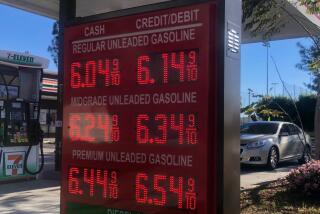Oil experts divided on main reason for price hikes
- Share via
The run-up in oil prices this year was not as steep as last summer’s record climb, but it was almost as mystifying.
Demand was low, the global economy was sagging, and the world’s oil consumers and producers were brimming with excess supply. Those factors ought to keep prices down, but the monthly average price of crude oil jumped $10 a barrel from February to April, another $10 in May and again in June. Gasoline prices in the United States rose 54 days in a row, and AAA called the increases through May “the largest five-month retail advance this century.”
Then over the last 10 days, oil prices have tumbled, falling to $59.52 a barrel Tuesday summoning memories of last year, when prices hit a record $147 on July 11 before falling. Renewed pessimism about the economy was one reason for the swoon, but the abrupt shift has been dizzying. And not entirely reassuring. Many regulators, oil analysts and oil executives say that the lurches in price this year -- even more than those last year -- must be attributable primarily to one factor: speculators.
“Here we go again,” Bart Chilton, a commissioner at the Commodity Futures Trading Commission, said late last month. “Crude oil prices are up 60% on the year. Supplies are at a 10-year high, and demand is at a 10-year low. You do the math. Why should prices be over $70?”
Last week, the commission said it would consider new measures to curb speculation and increase transparency in energy markets, where the agency’s data suggest that a substantial amount of oil trading was concentrated in the hands of just a few investment banks and trading firms. Also last week, the leaders of Britain and France urged measures to counter “damaging speculation.”
Regulators worry that even a small bubble in oil prices could stifle economic recovery by draining money from savings or other purchases, undercutting the government stimulus program and reigniting inflation.
“It’s almost as if these current prices are in an alternative universe,” hedge-fund manager Mike Masters, a fixture at congressional hearings on commodities oversight, said in an interview with the trade publication Mastering Derivatives. “You’ve got the speculative price of oil, and you’ve got what the actual price of oil would be.”
Speculation, many analysts note, is a loaded term. It conjures images of unprincipled middlemen who manipulate and bet on prices. In reality, “speculators” are simply investors who have no commercial use for oil and never plan to take delivery. They can include state pension funds and college endowments, as well as investment banks and hedge funds seeking to use oil futures the same way they use other financial instruments.
“ ‘Speculation’ isn’t a dirty word,” Chilton wrote in an e-mail. “Speculators are a necessary part of futures markets, and they play a critical and important role in the price discovery process. If, however, a group of entities is affecting the price of a critically important commodity in an uneconomic fashion, the CFTC has a responsibility to investigate and address it.”
Some oil experts, economists and analysts said supply and demand have been bigger factors than speculation in driving oil prices. And they expect costs to keep going up.
“We continue to gain confidence that the trough in the oil cycle has passed and a new upturn is underway,” Goldman Sachs oil analyst Arjun Murti wrote in a report last month.
He cited stagnant world oil supplies -- and declining production outside the Organization of the Petroleum Exporting Countries -- along with a gradual rise in demand. Goldman Sachs boosted its price forecasts by $10 a barrel, saying the cost would surpass $100 over the next couple of years.
Adam Sieminski, chief energy economist for Deutsche Bank, asked, “How long can a commodity stay below its replacement cost?” He estimated that the cost of finding a new barrel of oil is “at least $60 and might be $80.”
Chilton -- like others who see a bubble in oil prices -- notes the wave of money coming into oil markets from investors. Last year, the commodities commission estimates, about $200 billion flowed into regulated oil markets.
He said billions of dollars more probably flowed into unregulated, or “dark,” markets, where it is impossible to identify players or track trade volumes. Investment banks say money has been flowing into oil funds.
--
Mufson writes for the Washington Post.
More to Read
Inside the business of entertainment
The Wide Shot brings you news, analysis and insights on everything from streaming wars to production — and what it all means for the future.
You may occasionally receive promotional content from the Los Angeles Times.










